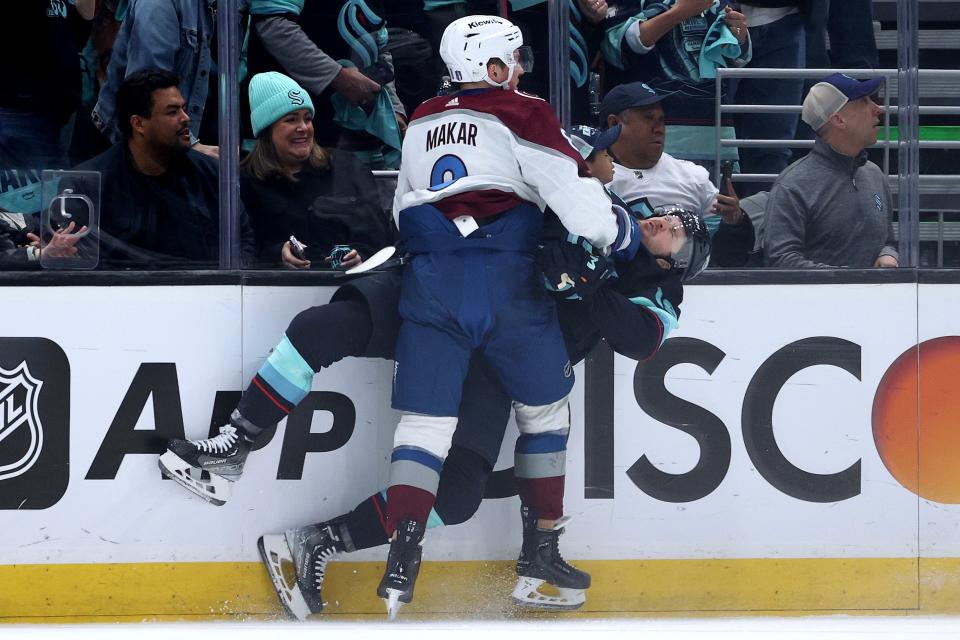During the second period of Game 1 of the Minnesota Wild-Dallas Stars series, Minnesota defenseman Matt Dumba delivered a big hit against Joe Pavelski. The Dallas forward hit his head on the ice and was placed in concussion protocol.
Originally, no call was made on the play, then a major penalty was called. After a review, Dumba was assessed a minor penalty for roughing.
The scene has played out several times in the first round, in plays involving Toronto Maple Leafs defenseman Morgan Rielly and Colorado Avalanche defenseman Cale Makar, among others.
What is the NHL’s rule for reviewing a major penalty and why is it being done?

Which NHL rule covers review of major penalties?
According to Rule 20.6, “Referees shall review all plays that result in the assessment of any Major Penalty (other than a Major Penalty for Fighting) for the purpose of confirming (or modifying) their original call on the ice. … Communication between the Situation Room and the On-Ice Officials shall be limited to contact between the appropriate Game Logger in the Situation Room and the Referee to ensure the Referee is receiving any and all video they might request, as well as the appropriate replay angles they may need to review the penalty call. There shall be no other contact or consultation between the On-Ice Official(s) and the NHL Situation Room, or with any other non-game participant. The Referee shall have the following options after video review of his own call: (i) confirming his original Major Penalty call; (ii) reducing his original Major Penalty call to a lesser penalty; or (iii) rescinding the original Major Penalty altogether.”
Why are major penalties called on the ice before the review?
Minor penalties cannot be reviewed. Referees need to call a major in order to initiate the review. This allows referees to make sure that a potential game-altering penalty is the correct call.
What was the initial incident that caused this rule to be adopted?
Coincidentally, it involved Pavelski. In the 2019 playoffs, the Vegas Golden Knights’ Cody Eakin shoved Pavelski, then with the San Jose Sharks. Pavelski lost his balance and hit his head on the ice, opening a cut. Referees, seeing the blood, called Eakin for a major penalty for cross-checking. San Jose, trailing 3-0 in Game 7, scored four times on the power play and won in overtime. Vegas players complained afterwards and even Pavelski later said he didn’t think the hit was worth five minutes. The expansion of video review to include major penalties was instituted in June 2019.
What are some of the reviews in the 2023 playoffs?
—Referees confirmed a match penalty on a hit by Toronto’s Michael Bunting on Tampa Bay Lightning defenseman Erik Cernak. Bunting was suspended for three games.
—Referees called Rielly for a boarding major against the Lightning’s Brayden Point in Game 3 but he ended up not being penalized after the review. Rielly stayed in the game and scored in overtime.
—Makar was assessed a minor penalty for interference for his Game 4 hit on Seattle’s Jared McCann, which occurred after McCann’s shot was deflected out of play into the netting.
“I believe that the puck is being caught by a fan as Canner is running into the end wall,” Kraken coach Dave Hakstol told reporters. “Late hit. Really late, no puck in play and our 40-goal scorer not available for the rest of the game and not going to be available going forward here.”
Hakstol said he was told by officials that “they felt there was a puck in play at the battle … I disagree with that obviously.”
—A review upheld a five-minute kneeling major to Minnesota’s Marcus Foligno in Game 5.
Does a reduced penalty after review mean there won’t be further discipline?
No, Makar received a one-game suspension for his hit on McCann. “The result of this play is a body check to a vulnerable player who is not eligible to be hit that causes an injury,” the league said in its suspension video.
This article originally appeared on USA TODAY: NHL playoffs: Why the league is reviewing major penalties